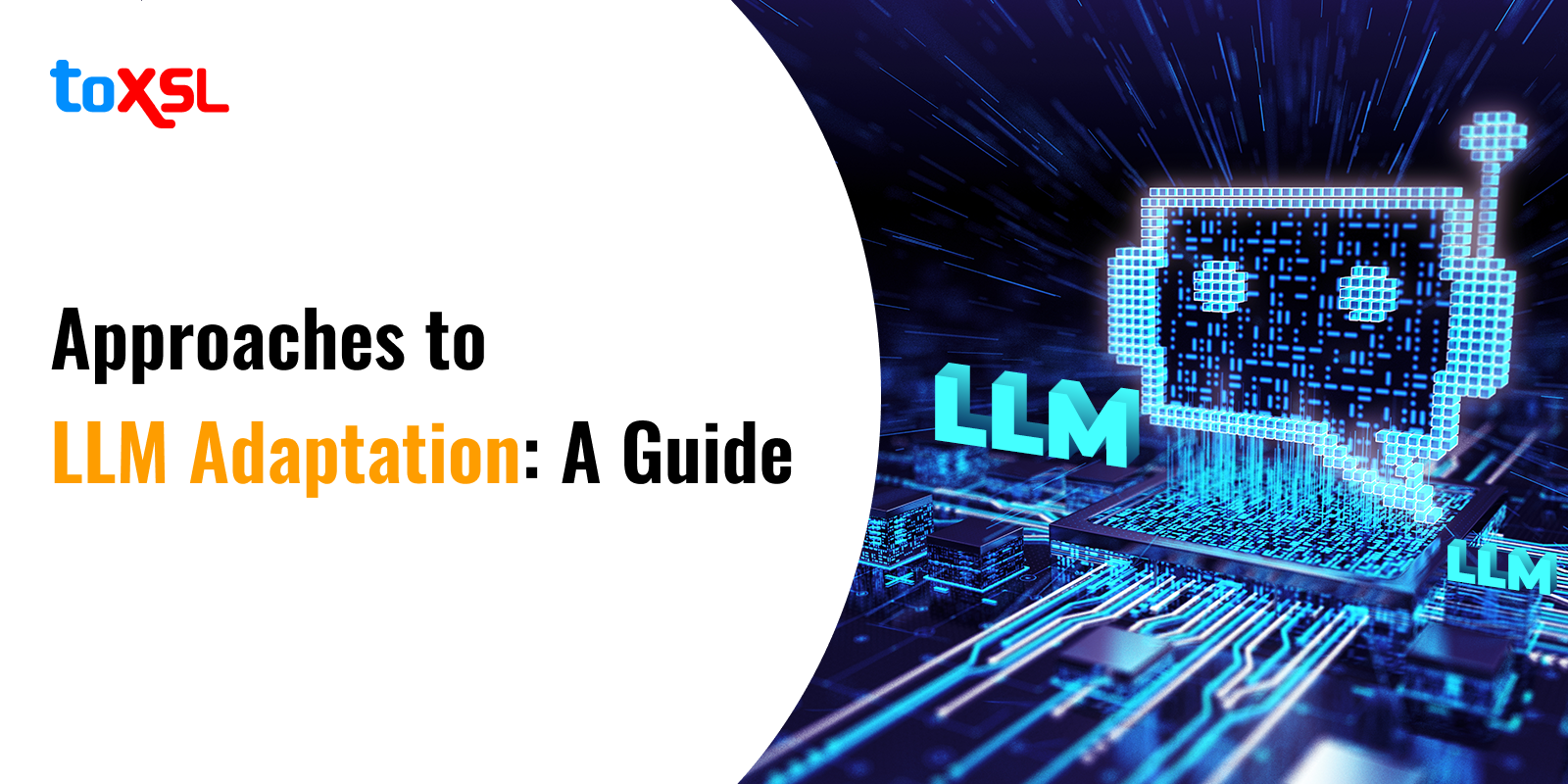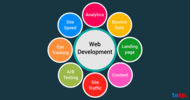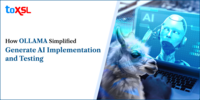- Jul 31, 2025
Share this post on:

Are you a business looking to adapt the LLM model? What are the ways in which businesses can adapt LLM models? This blog seeks to guide businesses and readers on how to navigate the era of LLMs, helping them make informed decisions.
With the introduction of Attention is All You Need, a paper that proposed the Transformer Model took the world by storm. The Transformer model outperformed the Google Neural Machine Translation model in the specific tasks, becoming the dominant model for Natural Language Processing (NLP) tasks.
The transformer model transformed the field of artificial intelligence, paving the way for the development of new powerful models such as GPT-4, BERT, and LLaMA. One such powerful model that can take the world by storm is the Large Language Model (LLM). Many organizations are incorporating LLMs into their tech stack.
Large Language Models(LLMs), with the help of their advanced capabilities, are offering high-quality solutions. But with the rising demand of LLMs, the demand for fine-tuning foundation models is also increasing. Businesses need to fine-tune the models in order to fulfil their needs and get the desired results. By the end of this blog, you will be able to understand LLM fine-tuning, when to fine-tune models and the approaches businesses can follow to adapt LLM into their operations.
So, let’s get started!
What is LLM Fine-Tuning?
Fine-tuning is a process of further training the trained model, which is already trained on a huge dataset. During fine-tuning, the trained model is further trained on the domain-specific dataset.
In LLM fine tuning, LLM refers to a large language model such as OpenAI’s whole GPT series. Fine-tuning a model is a great way to train model on specific data, as it is cost-effective in terms of computational resources and time. Furthermore, fine-tuning helps an organization achieve high performance on specific tasks with less data.
When to Fine-Tune Models
Fine-tuning models is essential in machine learning and deep learning when businesses want to use an already existing model to accomplish specific tasks and domains. Furthermore, this helps businesses fill the gaps between a general-purpose language model and a specialized model. Generally, businesses must fine-tune LLMs in the following scenarios:
1. Transfer Learning: The key component of a transfer model is fine-tuning. It is a machine learning technique where the information is gained from a pre-trained model to improve the model performance of the new task. Transfer learning allows you to fine-tune the pre-trained model. This improves the training process, saves time, and reduces the amount of data used.
2. Limited Data: Fine-tuning is great when you have less data available to perform a specific task. Hence, instead of training models from scratch, businesses can use pre-trained models for their tasks. Doing so, businesses can overcome the constraints due to lack of data and still achieve improvements in model accuracy.
3. Resource Efficiency: Training a deep learning model from the beginning takes a lot of time and substantial computational data. Whereas fine-tuning a pre-trained model is more powerful and efficient, where you have the privilege to directly skip the initial training stages while getting the solution to your tasks.
4. Task-Specific Adaptation: If you are using a pre-trained model for your specific task, fine-tuning it on your specific data becomes crucial. For example, if you want to develop a language model for a sentiment analysis for a specific domain like legal or medical, you must fine-tune the model in order to customize the model and get the results as per your requirements.
5. Continuous Learning: Fine-tuning is perfect for the continuous learning scenarios. These are those scenarios where the model needs to adapt to the constantly changing data over time. Using fine-tuning models allows you to easily update the model without training them from the beginning.
6. Bias Mitigation and Security: Fine tuning helps reduce biases (if any) present in a pre-trained model, making them more balanced, effective, and accurate. Also, the data used for these models is sensitive and can contain confidential information. Hence, it becomes necessary for businesses to fine-tune the model in a specific environment. Additionally, ensure that the model never leaves your controlled data, only accessible to the personnel.
What are the various approaches to LLM adaptation?
The latest class of Gen AI systems, driven by LLMs, including GPT-4, PaLM-2, andLlama 2, can easily create content by learning from huge datasets. Hence, these foundation models have generalized data that can easily be used for a wider range of use cases by organizations globally.
Moreover, some use cases require minimal fine-tuning and less data. However, some can be solved by offering a task instruction with no examples, known as zero-shot learning or a fewer number of examples, called few-shot learning.
Anyway, whatever approach businesses opt for, these opportunities are helping AI developers develop AI applications, which were not easy in the past. Hence, these LLM approaches have greater potential that can help businesses grow. Continue reading the blog
1. Pre-training: It is the process of training an LLM model using trillions of data tokens. The models use a self-supervised algorithm during training the process. Generally, training takes place by predicting the next token auto-regressively, known as causal language modeling. Pre-training of AI models usually takes multiple GPUs, requiring millions of GPU hours. Furthermore, the output that we receive from the pre-trained model is called a foundation model.
2. Continued Pre-training: The process of continued pre-training is known as second-stage pre-training. This involves further training of a foundation model with new domain data. Here, again, the algorithm used during the process of pre-training is the self-supervised algorithm. All model weights are used and some amount of original data is mixed with the new data.
3. Fine-tuning: As we discussed above, it is a process of training the pre-trained language model using an annotated dataset in a supervised way or reinforcement learning-based techniques. In fine-tuning is different than pre-training in two main ways, here’s how:
A. Annotated datasets used during supervised training contain the correct labels, answers, and preferences instead of self-supervised training.
B. Pre-training requires the billions or trillions of data tokens, whereas fine-tuning requires only thousands and millions of data tokens. However, the aim of fine-tuning is to enhance the abilities such as following the instructions, human alignment, and task performance.
Also, full fine-tuning encapsulates all parameters of the model, including fine-tuning on small models such as XMLR and BERT (100-300 million parameters), as well as large models such as Llama 2 and GPT3 (over 1 billion parameters).
C. Fine-tuning enhances the capabilities of pre-trained models. For example: instruction following and human alignment. The best example of a fine-tuned model with added instruction-following and human alignment capabilities is Chat-tuned Llama 2.
4. Retrieval Augmented Generation (RAG): So, are you a business looking to adapt the LLM model? Well, businesses can adapt LLMs by adding a domain-specific knowledge base. Introduced in 2020, RAG is the best example of search-powered LLM text generation. Retrieval-Augmented Generation (RAG) is a technique that enhances the accuracy and reliability of generative models by fetching the information from external sources. Chat LangChain is a popular example of a Q&A chatbot powered by RAG.
5. In-context Learning (ICL): In-context learning (ICL), also known as few-shot learning, is a technique of prompt engineering where task demonstrations are provided to the model as part of the prompt in natural language. ICL helps you use pre-trained models without fine-tuning them. However, you can combine ICL with fine-tuning to get more powerful LLMs.
Benefits of fine-tuning and adaptation: Technical Perspective
In this section, let us now explore the benefits of fine-tuning an LLM. Fine-tuning a model provides various advantages; here are a few of them:
1. Task Specific Adaption: LLMs have exceptional natural language understanding due to huge training datasets from various resources. Businesses can use these models to their advantage by fine-tuning them for tasks such as text classification, machine translation, and question-answering for particular domains such as healthcare, finance, and cybersecurity.
2. Domain-Specific Expertise: Fine-tuning large language models allows businesses to customise models as per their specific domain for improved performance. For example, the healthcare sector can use a fine-tuned model for medical diagnosis to identify diseases accurately and precisely.
3. Reducing Bias: There can be cases where businesses can see that pre-trained models are a bit biased. Hence, to reduce those biases, fine-tuning is the best option. This trains the model on safer and controlled datasets, leading to fair outcomes and addressing the issues related to any inappropriate content.
4. User Experience Enhancement: AI developers can integrate numerous applications with fine-tuned models to enhance the user experience. For example, businesses can fine-tune an LLM to develop a chatbot that gives relevant recommendations to visitors. This can help users with the purchasing decisions based on their needs.
To Summarize:
There is no limit to what extent LLMs can be integrated in our daily lives. So, at whatever stage your company is, it is time for you to leverage LLMs and drive innovation further.
With that, we have discussed the fine tuning of LLM models and various approaches to LLM adaptation. So, if you are looking for a software app development company that offers reliable artificial intelligence solutions incorporating LLMs and other AI models, ToXSL Technologies is here to help. Our seasoned developers have years of experience in developing the most profound and scalable software solutions that help our clients businesses grow.
So what are you waiting for? Talk to our expert today and understand how they can help you enhance your business.











